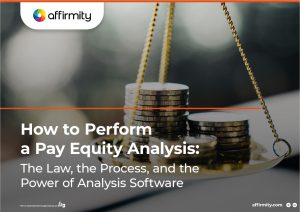Compensation and pay equity law isn’t standing still—an increasing number of states are passing pay transparency laws and making fresh demands for equal pay reporting. Federal contractors are already required to perform some form of pay equity analysis, and as the practice becomes essential for a wider range of organizations, it’s worth reviewing how to get started. Keep reading to discover the first three steps of the pay equity analysis process.
Step 1: Defining Fair Pay and Engaging Senior Decision-Makers
The approach you take to fair pay really depends on a number of things, but the first step boils down to defining what “fair pay” means to your organization. You will want to think about:
- Which laws and regulations affect your organization and its approach to pay equity
- How fair pay relates to the ethics, ethos, and mission of your organization
Obviously, the first point will set a baseline for what you need to do to remain basically compliant. However, due to new lawmaking trends, the goalposts for what is required in terms of pay equity are on the move.
Furthermore, your organization may project an ethical and principled image of itself that will require you to step beyond what is mandatory. With your answers in mind, it should be possible to shape the standards of fair pay that you wish to adopt as an organization.
However, this is also a decision you cannot make without engaging senior-level individuals early: executives, HR professionals, legal counselors, subject matter experts, and the analysts who already look into your fair pay issues. Without these people on board, it may not even be possible to accurately answer basic questions about how fair pay relates to your business. And you can expect your efforts moving forward to meet resistance at every turn.
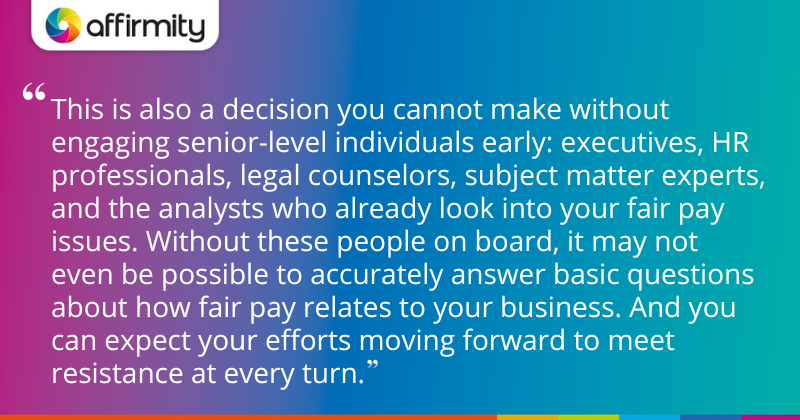
HOW DE&I HIGH PERFORMERS LEAD ON PAY EQUITY | ‘5 Challenges and High-Performance DE&I Tactics in the 2022 Future of Diversity, Equity, and Inclusion Report’
Step 2: Plan and Perform Your Analyses
Once you’ve established your organization’s exact definition of fair pay, you need to establish your analytics baseline. You should quickly understand where your organization sits in relation to where you think it should be, and your analysis plan must reflect the standards you have defined.
Overall Versus Corrected Gap Analyses
One decision you will need to make at this point is whether to focus on overall pay gap analyses or corrected pay gap analyses. In either case, you may be looking into the compensation difference between, for example, males and females, or people in different race classes, or different age groups, or the intersection between any combination of those characteristics. However:
- Overall pay gap analysis doesn’t account for any additional factors—it’s just a straightforward analysis of the numbers in each group in your organization, and the average pay difference between them.
- Corrected pay gap analysis additionally factors in elements such as job title, tenure, and prior education that may be contributing factors to the difference.
One approach isn’t inferior to the other. Corrected pay gap analyses can be used to mitigate the impact on the data of certain factors outside of the organization’s direct control. However, individual businesses may have a stance on whether those factors are part of their conception of “fair”.
For example, your business may not consider access to higher levels of education to be equitable, and may therefore not consider it essential to correct for this. Alternatively, “corrections” can be used to account for the effects of this and other factors on pay and group differences.
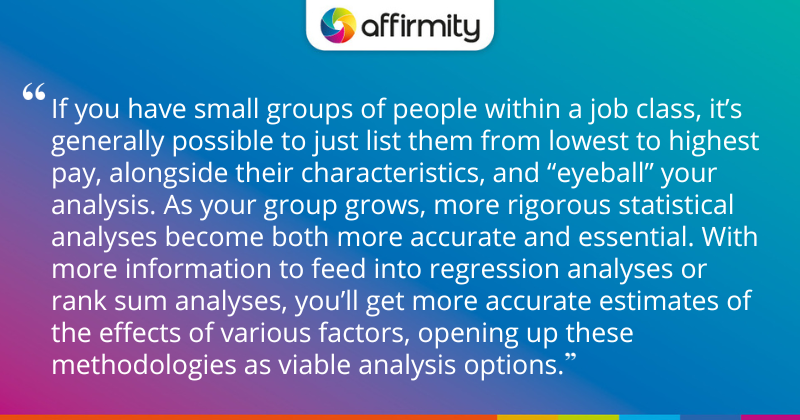
Analyses Within Specific Job Classes and Other Approaches
If you have small groups of people within a job class, it’s generally possible to just list them from lowest to highest pay, alongside their characteristics, and “eyeball” your analysis—it should be relatively easy to pick out which individual characteristics align with lower pay.
As your group grows, however, more rigorous statistical analyses become both more accurate and essential. With more information to feed into regression analyses or rank sum analyses, you’ll get more accurate estimates of the effects of various factors, opening up these methodologies as viable analysis options.
Another alternative is to take a workforce analytics approach. You could look at hire rates or promotion rates to see the ratio of people from different groupings going into different jobs. You could study whether there is parity between males and females or whether people in different race classifications are getting promoted. Turnover rates can also be important—as people leave, they take their pay with them, with obvious implications for your numbers.
Key Analyses for Different Stages of the Employee Lifecycle
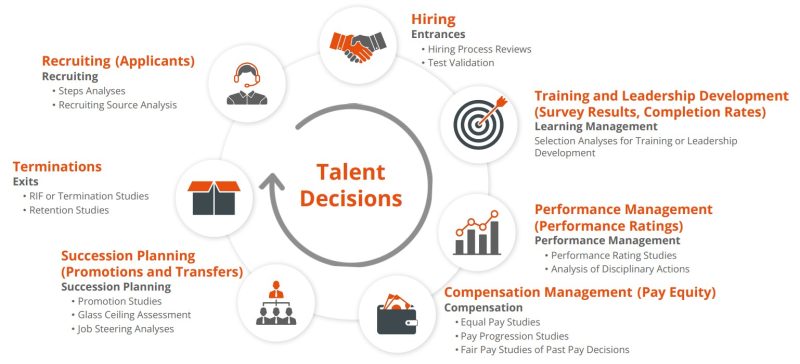
A diagram showing the cycle of talent decisions and different pay equity-related studies relevant at each stage.
The diagram above shows how every decision made in the employee lifecycle, from recruitment to exit/termination, generates data that can be collected and analyzed through an equity lens. Of course, it’s important to remember that recruitment and hiring have an outsized effect on overall pay equity. If people from certain backgrounds simply aren’t entering the business at higher levels or in more highly compensated areas, those differences are going to be sustained at every subsequent stage.
EQUITY INSIGHTS FROM OUR VIDEO SERIES | ‘OFCCP Compliance Series: Reviewing Your Hiring Processes to Ensure Fair Labor Practices’
Step 3: Investigate and Explain Your Inequities
Once you’ve found your pay differences, you’ll have to investigate the source of those differences.
Differences That Are Consistent With Your Standards
Look first at whether your differences are consistent with your standards. The good news is that if it turns out that your standards can explain your differences, you’re essentially done. Because statistical models can’t account for everything, you will have to do some legwork in order to prove that your standards are in play.
Specifically, you may have to talk to managers, HR personnel, or recruiters to consider everything that goes into determining variables such as starting pay. If factors reflecting standards weren’t considered in your statistical model, do they explain your pay differences? By making this discovery, you may be able to put systems in place so that the information can be captured in future pay studies, allowing you to focus on any differences that can’t be explained by standards.
Differences That Are Inconsistent With Your Standards
If, however, the differences are inconsistent with your standards, the real work begins. These differences will need to be addressed with programs, and finding their causes will often involve a larger outlay of effort and work. This is particularly true in large organizations, where there may be hundreds of job titles to analyze. Whatever your organization’s size, you’ll be glad that you involved individuals with budgetary control at the very beginning of this process.
Explanations of this type may involve biases in hiring decisions, performance metrics, or promotions decisions—things that will ultimately require remedial action such as training on how to make decisions in an unbiased fashion.
Some common root causes of pay difference include the effects of biases on:
- Hiring
- Starting pay
- Performance metrics
- Promotion chances
- Promotion pay increases
- Merit pay raises
- Bonus distributions
- High-potential identification
- Training and development opportunities
- Recruitment
It’s important to consider that these biases come as a package—over the course of any one career, inequity can accumulate because of biased decisions at each of these points.
Your organization may also experience:
- Structural and societal impacts on hire rates unique to your economic sectors
- Structural and societal impacts on hire rates for various positions/levels
- Tenure differences that occur because of gender-related life choices or work/life interruptions
- Differences in job or career desirability among different groups
- Governmental policies and procedures that have a cooling effect on some groups in various sectors
- Governmental and societal lack of support for class issues
While these are things that a business can exercise little direct control over, it can still participate in various programs or organizations to help counteract these impacts.
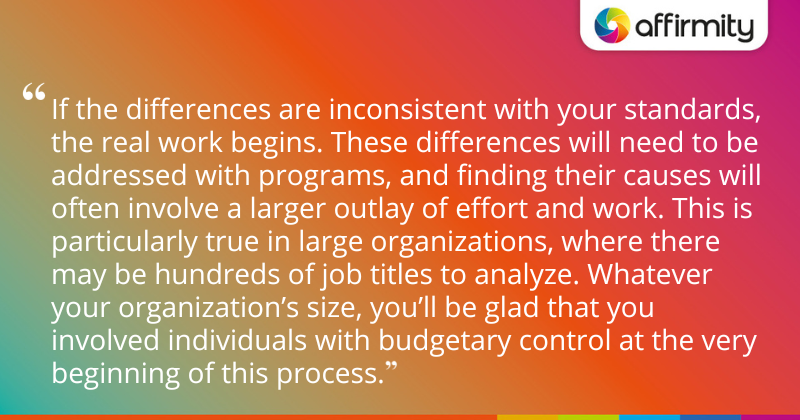
MORE ON EQUITY’S ROLE WITHIN DE&I | ‘3 Steps Towards a More Inclusive, Equitable, and Attractive Working Environment and Identity’
Continue Reading: Complete the Process and Learn About Pay Equity Law and Software
This blog post is an extract from our ebook, ‘How to Perform a Pay Equity Analysis: The Law, the Process, and the Power of Analysis Software’. In the full ebook, we’ll complete the process by looking at two additional steps covering how you can design and implement your corrective programs, and why you must return to validate and adjust those programs regularly. We also deal with:
- Established pay equity laws
- New trends in pay equity law that organizations must pay attention to
- A look at how pay equity analysis software can simplify the process
- 6 features to look out for when investing in pay equity analysis software
